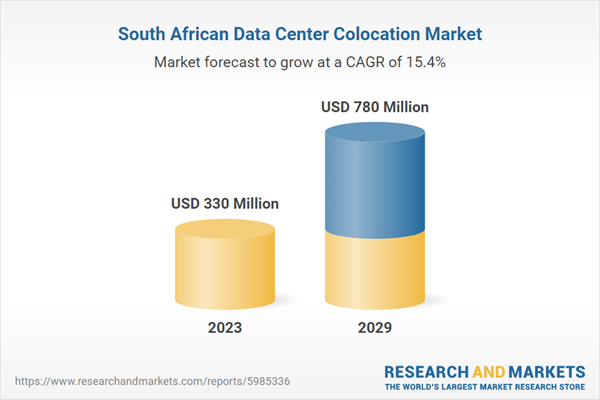Speak directly to the analyst to clarify any post sales queries you may have.
South Africa has around 51 operational colocation data centers. Most are being developed according to Tier III standards. The South Africa data center colocation market has the presence of both local and global operators, such as Teraco (Digital Realty), Africa Data Centres, Open Access Data Centres (OADC), Digital Parks Africa, NTT DATA, and Others.
In South Africa, Johannesburg is the prominent data center destination. In addition, it is well connected to other major cities in Africa and Europe, the Middle East, and Asia, making it an ideal location for a data center. Furthermore, the average rack power density in South Africa is around 4-5 kW as of 2024, which is likely to increase to 6-8 kW by 2029 on account of increased deployment of big data, IoT, AI, and ML workloads and the expansion by hyperscalers/cloud operators in the market.
The South Africa data center colocation market has a presence of several retail, wholesale, and hybrid colocation operators. Retail operators include Open Access Data Centres (OADC), Digital Parks Africa, Business Connexion, MTN, Vodacom Business. Wholesale operators include Africa Data Centres, Teraco (Digital Realty), Vantage Data Centers, and NTT DATA. Moreover, Equinix and Paratus are the new entrants in the industry. These companies are likely to disrupt and increase competition in the industry. The industry market share of several existing companies is likely to come down in the next 2-3 years due to the entry of several new players in the market, with nearby countries such as Nigeria and Kenya growing.
WHATS INCLUDED?
- A transparent research methodology and insights on the market's colocation of demand and supply.
- The market size is available in terms of utilized white floor area, IT power capacity, and racks.
- The market size is available in terms of Core & Shell vs. Installed vs. Utilized IT Power Capacity, along with the occupancy percentage.
- An assessment and snapshot of the colocation investment regarding core & shell area, power, and rack in South Africa and a comparison between African countries.
- The study of the existing South Africa data center market landscape and insightful predictions about industry size during the forecast period.
- An analysis of the current and future colocation demand in South Africa by several industries.
- Study on sustainability status in the region
- Analysis of current and future cloud operations in the region.
- Snapshot of upcoming submarine cables and existing cloud-on-ramps services in the region.
- Snapshot of existing and upcoming third-party data center facilities in South Africa
- Facilities Covered (Existing): 51
- Facilities Identified (Upcoming): 09
- Coverage: 27+ locations
- Existing vs. Upcoming (White Floor Area)
- Existing vs. Upcoming (IT Load Capacity)
- Data Center Colocation Market in South Africa
- Colocation Market Revenue & Forecast (2023-2029)
- Retail Colocation Revenue (2023-2029)
- Wholesale Colocation Revenue (2023-2029)
- Retail Colocation Pricing along with Addons
- Wholesale Colocation Pricing along with the pricing trends.
- An analysis of the latest trends, potential opportunities, growth restraints, and prospects for South Africa's colocation data center industry.
- Competitive landscape, including industry share analysis by the colocation operators based on IT power capacity and revenue.
- The vendor landscape of each existing and upcoming colocation operator is based on the existing/ upcoming count of data centers, white floor area, IT power capacity, and data center location.
TARGET AUDIENCE
- Real Estate Investment Trusts (REIT)
- Construction Contractors
- Infrastructure Providers
- New Entrants
- Consultants/Consultancies/Advisory Firms
- Corporate & Governments Agencies
VENDOR LANDSCAPE
Existing Colocation Operators
- Africa Data Centres
- Digital Parks Africa
- Open Access Data Centres (OADC)
- Teraco (Digital Realty)
- Vantage Data Centers
- Business Connexion
- Internet Solutions ZA
- MTN
- NTT DATA
- Vodacom Business
New Operators
- Equinix
- Paratus
KEY QUESTIONS ANSWERED
1. What is the count of existing and upcoming colocation data center facilities in South Africa?2. Who are the new entrants in South Africa's data center industry?
3. How much MW of IT power capacity is likely to be utilized in South Africa by 2029?
4. What factors are driving the South Africa data center colocation market?
Table of Contents
Methodology
Our research comprises a mix of primary and secondary research. The secondary research sources that are typically referred to include, but are not limited to, company websites, annual reports, financial reports, company pipeline charts, broker reports, investor presentations and SEC filings, journals and conferences, internal proprietary databases, news articles, press releases, and webcasts specific to the companies operating in any given market.
Primary research involves email interactions with the industry participants across major geographies. The participants who typically take part in such a process include, but are not limited to, CEOs, VPs, business development managers, market intelligence managers, and national sales managers. We primarily rely on internal research work and internal databases that we have populated over the years. We cross-verify our secondary research findings with the primary respondents participating in the study.

LOADING...
Table Information
| Report Attribute | Details |
|---|---|
| No. of Pages | 53 |
| Published | July 2024 |
| Forecast Period | 2023 - 2029 |
| Estimated Market Value ( USD | $ 330 Million |
| Forecasted Market Value ( USD | $ 780 Million |
| Compound Annual Growth Rate | 15.4% |
| Regions Covered | South Africa |









